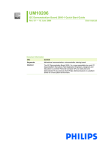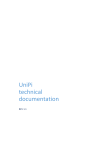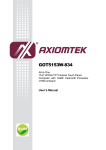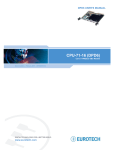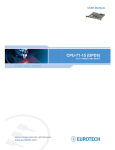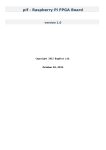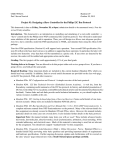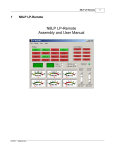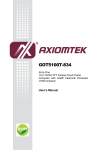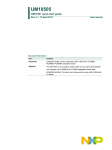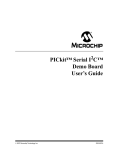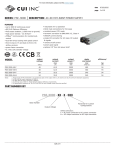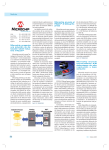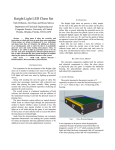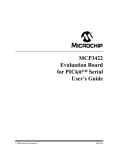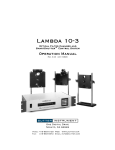Download Solution Guide to I2C BUS Communication
Transcript
Solution Guide to I2C BUS Communication Yiying Sun – Global Technology Centre Volume 1, October 2011 1. I2C Overview I2C, short for Inter Integrated Circuits, is a well known standard developed by Philips semiconductors (now NXP Semiconductors) in early 1980s. As its name suggests, it is used for communications between ICs resided on the same circuit board. Sometimes it is also called IIC, or I2C. Its original purpose was to provide an easy way to connect multiple peripheral circuits to a central processing unit inside a TVset. Before that time, the common method of inter-IC communication was via a parallel 8-bit wide bus. For example, the parallel data and address bus structure is used to connect memory to MCUs for data transfer. It results in high interconnection cost, such as more board area and I/O pins needed. The I2C bus can eliminate that drawback. It is a simple, bidirectional, 2-wire serial bus interface which supports moderate speed and short distance communication. By switching from parallel to serial communication, this 2-wire bus structure reduces the number of data lines and lowers general purpose input/output (GPIO) usage on the central processor, which enables to simplify designs and reduce costs. Originally, the I2C-bus was limited to 100 Kbps operation. Over time there have been several additions to the specification so that it is able to support up to 3.4 Mbps today. However, unlike other serial communication, the I2C bus is a multi-master bus, which means each device connected to the bus can control the bus. Because all communication takes place on only two wires, all devices must have a unique address to identify it on the bus. Communication between master and slave is bidirectional. Collision detection and arbitration mechanisms are present to prevent data corruption if two or more masters simultaneously initiate data transfer. Hence, there is no need for chip selection or arbitration logic, making it simple to implement in the design. With the advancement of the technology, the implementation of I2C bus is not limited to inside a single board only. It can be extended across multiple boards via bus extensions and control devices. For example, a host microcontroller on a main embedded board uses I2C to communicate with user interface devices located on a separate front panel board. Because of its simplicity and flexibility, the I2C bus is widely used in microcontroller / microprocessor-base systems across all industry segments. It is also adopted by a large and growing number of semiconductor manufacturers. These companies offer a variety of electronic devices, including memories, input and output devices, different types of sensors, real-time clocks, displays, and much more. 2. I2C Bus Theory of Operation In order to use the I2C bus properly and efficiently, it is important to understand how it works. Solution Guide to I2C BUS Communication Page 2 2.1 I2C Bus Hardware Architecture I2C bus defines a data signal line SDA and a clock signal line SCL which supports bidirectional data transfer between a master and several slaves. Regardless of how many devices are attached to the I2C bus, there are only two signals connected to all of them. A master is the device which initiates a data transfer on the bus and generates the clock signals to permit that transfer. The device being addressed by the master is called a slave. In Figure 1, the typical microcontroller (MCU)-based system use I2C bus for communication between the host MCU and multiple peripherals, such as memory, LCD drivers, data conversion devices, etc. In this case, the MCU is the master and the peripherals are slaves. Both the master MCU and slave peripherals can receive and transmit data. In I2C bus, both SDA and SCL are connected to a positive supply voltage (VCC) through pull-up resistors (see in Figure 1). Because SDA and SCL are open-drain, the devices connected to I2C bus can only drive these lines low or leave them open. The pull-up resistors RP pull the line up to HIGH (VCC) when the bus is free, or there is no device on the bus. RP commonly ranges from 1 kΩ to 10 kΩ, resulting in typical pull-up currents of about 1 mA and less. So far we discussed a single master implementation of I2C bus. But I2C bus is in fact a multi-master bus, which means more than one devices can be the master to control the bus at the same time without corrupting the message. For example, there are multiple MCUs connected to I2C bus. If two or more MCUs try to talk on the bus concurrently, they have to determine whether the bus is currently idle or not before I2C transferring. The arbitration procedure is used to decide which master is granted access, and which master should wait for the next idle time. VCC RP RP SDA SCL Central Processing Unit (MPU/MCU Peripheral Device 1 Peripheral Device 2 Peripheral Device 3 Peripheral Device n Figure 1 Connection of I2C Bus Devices As for the total number of devices connected to the I2C bus is determined by the maximum bus capacitance. According to I2C specification, a maximum bus Solution Guide to I2C BUS Communication Page 3 capacitive load is 400pF. This 400pF load includes all I2C devices as well as trace lengths. 2.2 I2C Bus Speed I2C bus is able to be operated at four speeds or modes: standard-mode (up to 100 Kbps), fast-mode (400 Kbps), fast-mode plus (up to 1 Mbps), and high speed mode (up to 3.4 Mbps). Most of the I2C devices available today support 400Kbps operation. Higher-speed operation may allow I2C to keep up with the rising demand for bandwidth in multimedia and other applications. The I2C devices are fully downward compatible, so any device may be operated at a lower bus speed. It makes it possible that a combination of different speed I2C devices exits in a system with the bus speed controlled by I2C master. 2.3 I2C Bus Communication I2C is a master-slave protocol. Therefore, the communication is initiated by a master only. When a master on the I2C bus wants to communicate with a slave, it first has to take control of the bus. This is only possible when the bus is free. Then the master device issues a START condition. A START condition is determined by a HIGH to LOW transition on the SDA line while SCL is HIGH. This condition informs all the slave devices to listen on the serial data line for their respective address. The bus is considered to be busy after the START condition. After a START condition has been signalled, the bus master will then send the unique ADDRESS of the target slave device along with a Read or Write flag. The slave with the corresponding address then responds with an acknowledgement (ACK) signal. Now the communication proceeds between the master and the Slave on the data line. The transmitter sends 8-bits of data to the receiver which replies with a 1-bit acknowledgement. When the communication is complete, the master issues a STOP condition indicating that everything is done. A STOP condition is indicated by a LOW to HIGH transition on the SDA line while SCL is HIGH. After the STOP condition is generated, the I2C bus is considered free again. Solution Guide to I2C BUS Communication Page 4 Matching Slave responses ACK Master issues START I2C Bus Idle Master sends slave ADDRESS Data transfer start Master flags READ/WRTIE Master issues STOP Slave Address Invalid Figure 2 I2C Communication 2.4 2C Address Scheme Each device connected to the I2C bus has a unique 7-bit or 10-bit address. I2C communication is 8-bit bytes transmission, so the master will send out the 7-bit address and add on the 8th bit which is the Read / Write flag. In another words, the last bit indicates if the master is going to send (write) or receive (read) data from the slave. When the address byte is sent, each slave device in the system compares the first seven receiving bits with its address. If they match, the device considers itself addressed by the master as a slave-receiver or slave-transmitter, depending upon the value of the data direction bit (8th bit). In order to prevent address clashes in a large I2C system, due to the limited range of the 7 bit addresses, a 10 bit address scheme is used to increases the available address range about ten times. However, the use of 10-bit address is not very common; therefore it is not discussed here in details. 3. Applications of I2C Bus The I2C-bus is a de facto industrial standard that is now widely used in computing, consumer electronics, communications, and industrial electronics. These systems all have some intelligent control usually by a central control processor – MCU or MPU. A typical I2C system usually has at least one MCU, peripheral memory, hard disk, A/D or D/A converters, graphic chip and other I/O ports. Nowadays, almost all MCUs are integrated a real I2C interface in hardware, but this should not restrict the use of Solution Guide to I2C BUS Communication Page 5 the I2C bus on other MCUs. Any MCU can be made to I2C communicate via general purpose I/Os using software routines. In current market, besides MCUs, I2C compatible devices are available in a wide range of functions. Some examples are listed including, but not limited to: • • • • • • • Serial EEPROM / RAM / FLASH I/O Expanders Real-Time Clocks Digital to Analog Converter / Analog to Digital Converter LCD/LED Drivers Sensors, such as temperature sensors, capacitive sensors, IR sensors, etc. MEMS Sensors, such as accelerometers, compass, etc. 4. I2C Legal Information The use and manufacturing of I2C devices is subject to a copyright and patents from NXP. This means that electronics system designers need to purchase a license from NXP to use I2C technology in their system. Fortunately, as of October 10, 2006, no licensing fees are required to implement the I2C protocol. However, fees are still required to obtain I²C slave addresses allocated by NXP. If you use an IC component which incorporating the technology has been licensed by IC manufacturers, then you can immediately use these components for free. In another case, if you use an FPGA in your design and you want to build an I2C technology, then you need to purchase a slave address from NXP. 5. Common Problems in I2C Applications 5.1 Mixed Voltage Levels Today’s electronics systems require different supply voltages to power their various components. With the increase demand of low power consumption, the high performance of MCUs and DSPs are implemented advanced process technology to get the supply voltages as low as 1.8V. On the other hand, some I2C peripheral devices continue to operate at 3.3V or 5V supplies. I2C-bus devices currently in the market range in supply voltage from 2 V to 5 V with commensurate I/O and threshold levels. It results that I2C devices with different voltage levels might be connected to the same bus. Since the I2C bus lines are bidirectional, interfacing I2C devices with different voltage levels is not straightforward, special level translation are necessary for this purpose. One solution for this is using a bidirectional voltage level translator without the need of a direction control signal. Here is one voltage level translation example, the TCA9406 from TI, to show how dual-channel signal switches can be used to Solution Guide to I2C BUS Communication Page 6 translate I2C signals (SDA and SCL) between mixed voltage levels. The TCA9406 is a dual bidirectional I2C-Bus Bus Voltage-Level Voltage Level translator with enable (OE) Input. It can interface between processors operating from 1.8 V to 3.3 V and the I2C slave devices operating from 2.3 V to 5.5 V. It supports standard and fast mode I2C devices and multiple masters. Figure 3 Typical Application Circuit of TCA9406 Table 1 Selection Guide for I2C Voltage Translators Order Code Manufacturer Part Number Newark Farnell / element14 Level Translation Range (V) Port A Port B I2C Speed Supported Standard Standardmode / FastFast mode / Fast Fast-mode Plus Standard Standardmode / FastFast mode / Fast Fast-mode Plus Maxim Integrated MAX3373EEKA+T 68K9426 1787504 1.2 to 5.5 1.65 to 5.5 NXP PCA9306D 70R6428 1831194 1.0 to 5.0 1.8 to 5.0 Texas Instruments PCA9306DCUTE4 97K6976 1053573 1.2 to 3.3 1.8 to 5.0 Standard Standardmode / FastFast mode Texas Instruments TCA9406DCTR 59T0097 1972384 1.65 to 3.6 2.3 to 5.5 Standard Standardmode / FastFast mode Solution Guide to I2C BUS Communication Page 7 Another solution for this issue is to use a multiplexer/switch. An I2C multiplexer basically expands the I2C Bus as it splits the SCL and SDA signals from the master into one or more SCL and SDA Channels, where each channel can support unique functions and needs. As each channel in the multiplexer is supply independent, each channel can be pulled to a different supply voltage. Another advantage of these multiplexers is their ability to isolate a section on the I2C bus through I2C software. This saves valuable pins on the processor, which can be used for additional functionality. Table 2 Selection Guide for I2C Multiplexers/Switches Order Code Manufacturer Part Number Newark Farnell / element14 Max Frequency (KHz) Configuration (IN:OUT) NXP PCA9540BD 70R6561 1831206 400 1:2 NXP PCA9544APW 70R6598 1831207 400 1:4 NXP PCA9546APW 70R6610 1831208 400 1:4 NXP PCA9547PW 70R6615 1831209 400 1:8 NXP PCA9548APW 70R6620 1831210 400 1:8 PCA9544APW 66K4023 1470501 400 1:4 PCA9545APWR 66K4031 1652260 400 1:4 PCA9546APWT 67K8254 1564905 400 1:4 PCA9548APWR 67K8253 1607855 400 1:8 Texas Instruments Texas Instruments Texas Instruments Texas Instruments 5.2 I2C Address Conflicts As mentioned previously, a 7 or 10-bit addressing scheme is used to identify each device on I2C bus. This address is usually defined by device manufacturers. Therefore, it is possible that two different functions of devices with same address, such as LCD driver and temperature sensor, are connected to same I2C bus. It will cause addressing conflicts. One multiplexer/switch is a solution for address conflicts. The multiplexer splits the I2C bus into several sub-branches and allow the I2C master to select and address one of multiple identical devices, thus resolving address conflict issues. The selection guide for multiplexers/switches is shown in Table 2. 5.3 Limited Distance Communication I2C is essentially a short-distance bus protocol for on board communication. The maximum distance depends on the load of the bus and the speed which it operates Solution Guide to I2C BUS Communication Page 8 at. The I2C bus capacitance limit of 400 pF restricts practical communication distances to a few meters. Meanwhile, if the designer needs to go far at high speed, he has to sacrifice the communication distance. Fortunately, with the I2C repeaters/ buffers, you can solve the dilemma without any degradation of system performance. These repeaters can provide I2C bus expansion and can successfully extend the line capacitance to greater than the 400pF capacitance. Additionally, these repeaters/buffers also support voltage level translation and are able to resolve address conflicts. Figure 4 is an example for the TCA9509 I2C repeater from TI to solve this issue. The TCA9509 is 5-V tolerant, so it does not require any additional circuitry to translate between 0.9-V to 5.5-V bus voltages and 2.7 V to 5.5 V bus voltages. In this example, the system master is running on a 1.1 V I2C bus, and the slave is connected to a 3.3-V bus. Both buses run at 400 kHz. Master devices can be placed on either bus. The TCA9509 buffers both the serial data (SDA) and the serial clock (SCL) signals on the I2C bus, thus allowing 400 pF bus capacitance on the B-side. This device can also be used to isolate two halves of a bus for voltage and capacitance. Figure 4 Texas Instruments TCA9509 I2C Repeater Table 3 Selection Guide for I2C Buffers / Repeaters Order Code Manufacturer Part Number Newark Farnell / element14 Max Frequency (KHz) Supply Voltage (V) NXP PCA9515ADP 70R6482 1831200 400 3.0 ~3.6 NXP PCA9515D 70R6483 1831201 400 3.0 ~3.6 NXP PCA9517D 71M0457 1831202 400 2.7 ~5.5 NXP PCA9511ADP 70R6469 1831198 400 2.7 ~ 5.5 Solution Guide to I2C BUS Communication Page 9 NXP Texas Instruments Texas Instruments Texas Instruments Texas Instruments 5.4 PCA9512ADP 70R6472 1831199 400 2.7 ~ 5.5 PCA9515AD 80K2690 1792276 400 2.3 ~ 3.6 PCA9517D 71M0457 1703190 400 0.9 ~ 5.5 PCA9518DW 53M3802 -- 400 3.0 ~ 3.6 TCA9509RVHR 51T4809 1926947 400 27 ~ 5.5 Mixed Speed Operation As we know, currently I2C bus supports four different data rates: standard mode (100 Kbps), fast mode (400 Kbps), fast-mode plus (1 Mbps), and high-speed mode (3.4 Mbps). According to I2C specification, if different frequency devices are connected in the same bus in an application, the lowest frequency must be used to guarantee a safe communication. For example, devices designed for the 100 kHz specification are not suitable to work properly at 400 kHz, while the opposite is true. In applications where upgrades have been performed by using newer 400 kHz devices while keeping the 100 kHz legacy devices, it may become necessary to separate the 400 kHz devices from the 100 kHz devices when a 400 kHz I2C transfer is performed. An I2C bus repeater can be used for this purpose. One side of the device will have all the devices running at one frequency while the other side will have all the devices running to another frequency. The selection guide for I2C repeaters is shown in Table 3. 5.5 Increased Complexity of PCB Routing According to I2C specification, the number of devices connected to the same bus is limited by the total bus capacitive load of 400 pF, and also by the address space. Suppose the total capacitance of I2C devices in one system is less than 400 pF, for a 7-bit address scheme, the maximum number of I2C devices that are allowed to communicate in the same bus is 128. In a typical application, the master device usually is a processor, and every slave device is linked to the processor directly via SDA and SCL lines. When designing out such a PCB, all necessary signals have to be routed directly from the processor to the I2C devices. This type of layout takes up a lot of board space, becomes tedious in trying to correctly lay it all out, and ends up being an expensive approach. In order to ease PCB routing, I2C I/O expander is introduced between a master and multiple slaves. One side of the I/O expander is connected to the I2C master devices, and the other side is connected to multiple slave devices, shown in Figure 5. The I/O expander can also easily enhance system IO functionality, such as LED controls, PWM and real time clock functions, keypad controls, and GPIOs. Solution Guide to I2C BUS Communication Page 10 I2C Slave Devices Slave 1 I2C Master Device Slave 2 I2C I/O Expander Slave 3 Slave n Figure 5 The I2C System With an I/O Expander Table 4 Selection Guide of I2C I/O Expanders Order Code Newark Farnell / element14 Max Frequency (KHz) ADP5587ACPZ-R7 69R7646 1799906 400 18 CAT9555WI-T1 08R5467 1718510 400 16 MAXIM MAX7311AUG+ 89K6080 -- 400 16 MAXIM MAX7312ATG+ 28K3566 -- 400 16 MAXIM MAX7315ATE+ 61K0645 -- 400 8 MICROCHIP MCP23017-E/SP 31K2959 1332088 1700 16 MICROCHIP MCP23018-E/MJ 31K2960 1854489 3400 16 MICROCHIP MCP23008-E/P 08J8737 1439387 1700 8 MICROCHIP MCP23009-E/SS 07P9508 1854487 3400 8 NXP PCA8574TS 61M8240 1506642 400 8 NXP PCA8575DB 61M8241 1506643 400 16 NXP PCA9500PW 70R6437 1831195 400 8 NXP PCA9501PW 70R6442 1831196 400 8 NXP PCA9535PW,112 70R6540 1627049 400 16 NXP PCA9539PW,118 70R6557 1831205 400 16 PCA9535DWR 63K6052 1575233 400 16 PCF8575CDBE4 97K6980 1053571 400 16 TCA6408APWR 55T7325 1903303 400 8 Manufacturer Analog Devices Catalyst Semiconductor Texas Instruments Texas Instruments Texas Instruments Part Number Solution Guide to I2C BUS Communication No. of I/Os Page 11 Texas Instruments Texas Instruments TCA6416APWR 10R6151 1754897 400 16 TCA6424ARGJR 01T0713 1863866 400 24 6. Special Function I2C Devices I2C bus is currently popular in electronics world and widely supported by IC manufacturers. Engineers can easily find an MCU integrated with I2C interface from different IC vendors. Apart from the processors, more I2C-bus compatible devices incorporate an on-chip interface which allows them to communicate directly with each other via the I2C-bus. They include memories, LED/LCD drivers, sensors, DACs/ADCs, and so on. 6.1 I2C Serial EEPROM Serial EEPROMs are widely used in many different applications where data retention during power-off is essential. These EEPROMs are designed to provide simple, but flexible data storage for most popular MCU-based solutions. They need only two wires to communicate the host processor. The MCU can use any tow available I/O pins to emulate the operation of the SDA and SCL signals required for I2C communications, shown in Figure 6. For a write operation, the microcontroller first sends a start condition. Then the control byte is sent. The control byte consists of the device code for the specific device that is being addressed, the address of the memory block being accessed, and a bit that indicates a write operation is being performed. The EEPROM then acknowledges receipt of the byte. The MCU then sends the specific memory address of the byte being written to. The EEPROM acknowledges again. The MCU then sends the data to be written into the memory byte. After the EEPROM acknowledges the data, the MCU sends a stop condition. Similar process is used to read from EEPROM. The only difference is that the control byte is sent twice, once before the MCU sends the address byte and a second time before the EEPROM returns the requested data byte. The read/write bit of the control byte is also set to a read operation. Solution Guide to I2C BUS Communication Page 12 VCC RP RP SDA SCL P1.0 P1.1 Central Processor (MPU/MCU) SDA SCL I2C Serial EEPROM Figure 6 I2C Serial EEPROM Interface with an MCU 6.2 LED Drivers with I2C Interface LED lighting becomes more and more popular in current market with the advancement of LED technology. LED drivers are required to ensure the proper operation of LEDs, and able to add extra intelligence to the lighting system, such as blinking, dimming, and color mixing. The purpose of this device is to free the processor from the LED controls, which allows the processor to focus on other tasks in the application. Without the I2C LED drivers, the host MCU needs to send out repeated commands to turn LEDs on and off. This significantly increases the amount of traffic on the MCU and uses up one of the MCU timers. The LED driver instead requires to only program the individual port with the frequency and duty cycle, and then it only requires one command from the master MCU to control the LEDs. VCC RP RP SDA SCL P1.0 P1.1 Central Processor (MPU/MCU) SDA SCL I2C LED Driver Figure 7 I2C LED Driver Interface with an MCU Solution Guide to I2C BUS Communication Page 13 6.3 I2C Digital Sensors I2C compatible sensors can communicate with the master MCU via two-wire bus. The most common used I2C sensors are temperature sensors. Many systems across a variety of applications require some implementation of temperature monitoring. These sensors can monitor the temperature of the thermal diode inside the CPU or the diode connected to transistors, and can trigger an interrupt or alert output. They are also able to produce accurate digital readings of the ambient temperature and can be used to trigger interrupt, shut-down, or over-temperature alarms. Figure 8 shows a typical connection of temperature sensors and the host MCUs. VCC I2C Temperature Sensors Figure 8 Interface I2C Temperature Sensors with the MCU 7. Development Tools For I2C Bus 7.1 NXP I2C 2002-1A Evaluation Kit The I2C 2002-1A Evaluation kit is a low cost I2C based platform that allows designers to use their Personal Computer (PC) to easily test and demonstrate I2C devices in a platform that allows multiple operations to be performed in a setting similar to a real system environment. The evaluation board features 11 different I2C slave devices, including 1 temperature sensor, 1 I2C repeater, 3 I2C I/O expanders, 2 I2C LED drivers, 1 I2C EEPROM, 1 I2C buffer, and 2 I2C switches. It also supports for easy programming and evaluation of various general purposes I2C products from NXP. This evaluation board can be use to learn how to program and Blink LEDs using the GPIOs and/or the LED drivers, learn how the multiplexer, serial EEPROM, and temperature sensor work, learn how to program the multiplexed I2C EEPROM. This kit also includes a PC graphical interface that allows easy manipulation of I2C devices. Solution Guide to I2C BUS Communication Page 14 Figure 9 I2C 2002-1A Evaluation Board 7.2 Microchip PICkit Serial I2C Demo Board The PICkit Serial I2C Demo Board demonstrates I2C serial communications and operation of the following devices: • • • • • 24LC02B - 2Kbit Serial EEPROM MCP9801 - High-Accuracy Temperature Sensor MCP3221 - Low-Power 12-Bit A/D Converter TC1321 - 10-Bit Digital-to-Analog Converter MCP23008 - 8-Bit I/O Expander The PICkit Serial I2C Demo Board was designed to easily connect to the PICkit Serial Analyzer (DV164122). The PICkit Serial Analyzer provides the I2C master mode serial communications and power. The PICkit Serial I2C Demo Board devices all operate in the I2C slave mode. Figure 10 PICkit Serial I2C Demo Board Solution Guide to I2C BUS Communication Page 15 7.3 Total Phase I2C Development Kit (TP120112) Total Phase's I2C development kit TP120112 allows developers to develop and debug an I2C bus on an embedded system. With this kit, developers can exercise target devices on an I2C bus as a master device, simulate an I2C master or slave device, program and verify I2C-based memory devices, passively monitor an I2C bus in real-time. The I2C development kit contains an Aardvark I2C/SPI host adapter, a Beagle I2C/SPI Protocol Analyzer, and one I2C/SPI Activity Board. The Aardvark I2C/SPI host adapter can actively send and receive I2C message as a master or slave device. With this interface, a PC can communicate directly with I2C devices. Because every I2C device is different, this kit offers a free API that allows users to create custom applications to interface with I2C based systems. The Beagle analyzer provides a real-time bus monitoring and data capture for users’ systems. Figure 11 TP120112 I2C Development Kit 8. Reference Design 8.1 I2C Bus Slave Reference Design Figure 12 shows the block diagram of the I2C bus-interface slave reference design from Digital Core Design. The reference design provides an interface between a target device (e.g. memory, LCD display, and pressure sensors) and an I2C bus. It can work as a receiver or transmitter depending on the working mode determined by the master. It supports slave transmit and receive operations, speeds up to 400 Kbps, and 7-bit addressing. Meanwhile there is no programming required. This Solution Guide to I2C BUS Communication Page 16 reference design can be used in automotive audio-video systems and embedded systems. Figure 13 I2C Bus-Interface Slave Block Diagram 8.2 I2C Bus Master Controller Reference Design Figure 13 shows the reference design for I2C bus master controller form Lattice Semiconductor. It is intended to demonstrate how a fast and configurable I2C-Bus Master Controller can be constructed and utilized in a Lattice CPLD/FPGA device. The I2C Master Controller accepts commands from a microprocessor. These commands are decoded into I2C slave device read/write cycle transactions. The I2C bus transactions can be configured to be 1 to 256 bytes in length. With the flexibility that this I2C-Bus Master Controller offers, a designer can communicate with up to 128 different I2C slave devices operating in standard or fast mode with transactions ranging from 1 to 256 bytes. Furthermore, the I2C Master Controller can operate in interrupt or polling mode. This means that the microprocessor programmer can choose to poll the I2C Master for a change in status at periodic intervals or wait to be interrupted by the I2C Master Controller when data needs to be read or written. Solution Guide to I2C BUS Communication Page 17 Figure 14 I2C Master Controller I/O Interface 9. Summary There are thousands of I2C devices on the market today, ranging from data converters, serial EEPROM, digital sensors, to video processors. Those devices are built in on-chip programmable registers to provide an ideal low-cost solution to establish communications between these intelligent devices and the central controller. Nearly every microcontroller vendor has taken care of the physical implementation of the bus, even if some of the MCUs do not have on-chip I2C hardware interface, the I2C bus still can be implemented using software. In addition, since silicon area and I/O pins heavily influence the IC price, I2C has a lot to offer in cost-sensitive applications. 10. References [1] www.i2c-bus.org [2] Introduction to I2C, http://www.eetimes.com/discussion/beginner-scorner/4023816/Introduction-to-I2C [3] I2C Manual, http://www.nxp.com/documents/application_note/AN10216.pdf [4] I2C-bus Specification and User Manual, http://www.nxp.com/documents/user_manual/UM10204.pdf [5] I2C Guide, http://www.ti.com/lit/sg/sszc003c/sszc003c.pdf Solution Guide to I2C BUS Communication Page 18 Disclaimer The information contained in this document is for general purposes only. Thanks to the suppliers/websites who provided the information and while we endeavour to keep the information up to date and correct, we make no representations or warranties of any kind, express or implied, about the completeness, accuracy, reliability, suitability or availability with respect to the website or the information, products, services, or related graphics contained on the website for any purpose. Any reliance you place on such information is therefore strictly at your own responsibility. Solution Guide to I2C BUS Communication Page 19



















